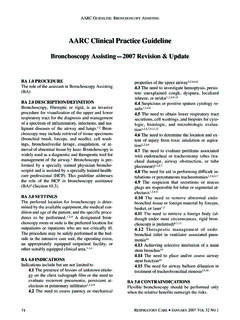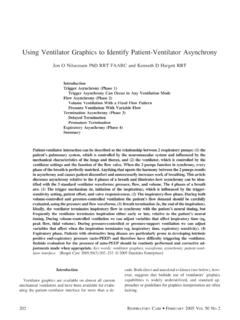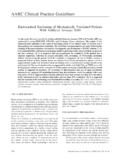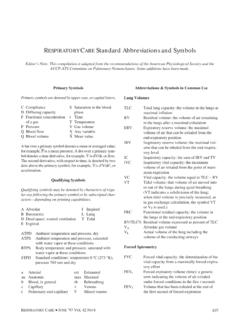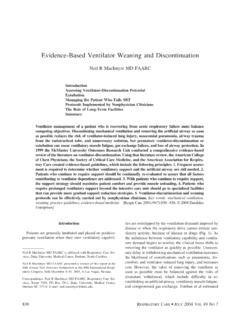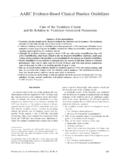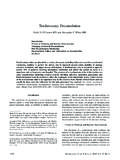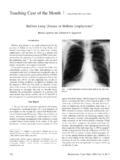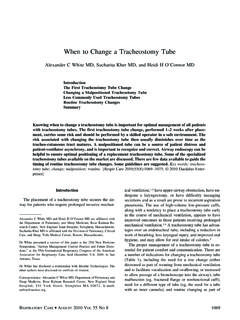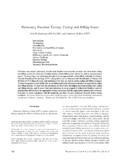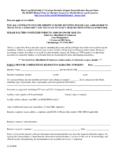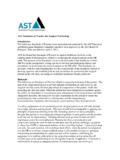Transcription of AARC Clinical Practice Guideline - Respiratory Care
1 AARC Clinical Practice GuidelineIncentive Spirometry: 2011 Ruben D Restrepo MD RRT FARRC, Richard Wettstein MMEd RRT,Leo Wittnebel MSIS RRT, and Michael Tracy RRT-NPS RPFTWe searched the MEDLINE, CINAHL, and Cochrane Library databases for articles publishedbetween January 1995 and April 2011. The update of this Clinical Practice Guideline is the result ofreviewing a total of 54 Clinical trials and systematic reviews on incentive spirometry. The followingrecommendations are made following the Grading of Recommendations Assessment, Development,and Evaluation (GRADE) scoring system. 1: Incentive spirometry alone is not recommended forroutine use in the preoperative and postoperative setting to prevent postoperative pulmonarycomplications. 2: It is recommended that incentive spirometry be used with deep breathing tech-niques, directed coughing, early mobilization, and optimal analgesia to prevent postoperative pul-monary complications.
2 3: It is suggested that deep breathing exercises provide the same benefit asincentive spirometry in the preoperative and postoperative setting to prevent postoperative pul-monary complications. 4: Routine use of incentive spirometry to prevent atelectasis in patients afterupper-abdominal surgery is not recommended. 5: Routine use of incentive spirometry to preventatelectasis after coronary artery bypass graft surgery is not recommended. 6: It is suggested that avolume-oriented device be selected as an incentive spirometry words: breathing exercises,incentive spirometry, postoperative pulmonary complications, Respiratory physiotherapy.[Respir Care2011;56(10):1600 1604. 2011 Daedalus Enterprises]IS DESCRIPTION/DEFINITIONP ostoperative pulmonary complications are reported inthe range of 2 39%,1,2and include atelectasis, pneumonia,and Respiratory failure.
3 Upper-abdominal surgical proce-dures are associated with a higher risk of complications,followed by lower-abdominal surgery and thoracic sur-gery. Preoperative and postoperative Respiratory therapyaims to prevent or reverse atelectasis and improve risk and severity of complications can bereduced by the use of therapeutic maneuvers that increaselung volume. Incentive spirometry has been routinely con-sidered a part of the perioperative Respiratory therapy strat-egies to prevent or treat complications. Incentive spirom-etry is designed to mimic natural sighing or yawning byencouraging the patient to take long, slow, deep decreases pleural pressure, promoting increased lungexpansion and better gas exchange. When the procedure isrepeated on a regular basis, atelectasis may be preventedor maneuvers such as positive ex-piratory pressure (PEP) and vibratory PEP do not mimicthe sigh.
4 While incentive spirometry is widely used clin-ically as a part of routine prophylactic and therapeuticregimen in perioperative Respiratory therapy, its clinicalefficacy remains PROCEDUREI ncentive spirometry, also referred to as sustained max-imal inspiration, is accomplished by using a device thatprovides feedback when the patient inhales at a predeter-mined flow or volume and sustains the inflation for at leastDr Restrepo, Mr Wettstein, and Mr Wittnebel are affiliated with theDepartment of Respiratory Care, The University of Texas Health Sci-ences Center at San Antonio, San Antonio, Texas. Mr Tracy is affiliatedwith the Department of Respiratory Therapy, Rainbow Babies and Chil-dren s Hospital, Cleveland, authors have disclosed no conflicts of : Ruben D Restrepo MD RRT FAARC, Department ofRespiratory Care, The University of Texas Health Sciences Center at SanAntonio, 7703 Floyd Curl Drive, MSC 6248, San Antonio TX : OCTOBER2011 VOL56 NO105 seconds.
5 The patient is instructed to hold the spirometerin an upright position, exhale normally, and then place thelips tightly around the mouthpiece. The next step is a slowinhalation to raise the ball (flow-oriented) or the piston/plate (volume-oriented) in the chamber to the set target. Atmaximum inhalation, the mouthpiece is removed, followedby a breath-hold and normal exhalation. Instruction ofparents, guardians, and other health caregivers in the tech-nique of incentive spirometry may help to facilitate thepatient s appropriate use of the technique and assist withencouraging adherence to LIMITATIONS OF METHODThe usefulness of prophylactic Respiratory therapy, in-cluding incentive spirometry, for the prevention of clini-cally relevant postoperative pulmonary complications effectiveness of incentive spirometry may de-pend on patient selection, careful instruction, and su-pervision during Respiratory training and insufficient self-ad-ministration of incentive spirometry may result inlack of resolution of postoperative strongly suggests that incentive spirom-etry alone may be inappropriate to prevent or treatpostoperative therapy.
6 With or without incentive spi-rometry, may have similar Clinical and postoperative respiratorytherapy that includes deep breathing exercises,directed cough, early mobilization, and optimalanalgesia,12-14with or without incentive spirom-etry, appears to be effective in preventing or re-versing complications after thoracic surgery,15-19cardiac surgery,20-22abdominal surgery,23-29andperipheral surgery in obese is lacking for benefit of incentivespirometry in reducing pulmonary complicationsand in decreasing the negative effects on pulmo-nary function in patients undergoing coronary ar-tery bypass graft , spirometry has not been associ-ated with significant improvements of inspiratorycapacity prior to laparoscopic bariatric surgeryand may not be useful to prevent postoperativedecrease in lung , is no significant difference betweendeep breathing with directed cough and incentivespirometry in the prevention of postoperative pul-monary complications following patients with neuromuscular disease, in-centive spirometry may not be as effective asintrapulmonary percussion ventilation in prevent-ing care care and skilled nursing careIS screening of patients at risk for post-operative complications to obtain baseline flow or ,39, therapy that includes daily sessions ofincentive spirometry plus deep breathing exercises,directed coughing.
7 Early ambulation, and optimal an-algesia may lower the incidence of postoperative pul-monary of pulmonary atelectasis or conditionspredisposing to the development of pulmonary atel-ectasis when used or thoracic bed in patients with of pain of thoracic or abdominal lung defect associated with adysfunctional diaphragm or involving the respi-ratory with inspiratory capacity with neuromuscular with spinal cord spirometry may prevent atelectasis as-sociated with the acute chest syndrome in patientswith sickle cell , patients undergoing coronary artery spirometry and positive airwaypressure therapy may improve pulmonary func-tion and 6-minute walk distance and reduce theincidence of postoperative ,48IS who cannot be instructed or supervised toassure appropriate use of the in whom cooperation is absent or patientsunable to understand or demonstrate proper use of thedeviceAARC CLINICALPRACTICEGUIDELINE:INCENTIVESPIRO METRY.
8 2011 RESPIRATORYCARE OCTOBER2011 VOL56 young patients and others with devel-opmental who are confused or who are heavily sedated or spirometry is contraindicated in patientsunable to deep breathe effectively due to pain, dia-phragmatic dysfunction, or opiate unable to generate adequate inspirationwith a vital capacity 10 mL/kg or an inspiratorycapacity 33% of predicted HAZARDS AND unless performed as secondary to interruption of prescribedoxygen ASSESSMENT OF procedure involving abdomen or predisposing to development of atel-ectasis, including immobility and abdominal bindersIS ASSESSMENT OF or improvement in signs of Respiratory of pulse in previously absent or dimin-ished breath radiographic arterial oxygenation (PaO2,SaO2,SpO2), reduced FIO2requirementIS incentive incentive spirom-eters are frequently associated with lower im-posed work of breathing and larger inspira-tory lung volume than flow-oriented , spirometers with a low ad-ditional imposed work of breathing might bemore suitable for postoperative incentive personnel should to implement standard/uni-versal of techniques for proper op-eration and Clinical application of to instruct patient in to respond appropriately toadverse to identify need for therapy,response to therapy, and need to discontinueineffective therapyIS MONITORINGD irect supervision of every patient use of incentive spi-rometry is not necessary once the patient has demonstratedmastery of technique.
9 However, intermittent reassessmentis essential to optimal of patient performance and of of volume, flow, and breath-holdgoals within reach of patient to encourage per-forming without supervisionIS FREQUENCYE vidence is lacking for a specific frequency for use ofincentive spirometry. Some suggestions have been madein Clinical breaths every one53to two42hours breaths, 5 times a breaths every 4 hours36 After proper instruction and return demonstration, thepatient should be encouraged to perform incentivespirometry INFECTION for Disease Control guidelines for stan-dard precautions should be equipment and supplies should be appropri-ately disposed of or disinfected according to manu-facturer RECOMMENDATIONSThe following recommendations are made following theGrading of Recommendations Assessment, Development,and Evaluation (GRADE) scoring system54:AARC CLINICALPRACTICEGUIDELINE:INCENTIVESPIRO METRY.
10 20111602 RESPIRATORYCARE OCTOBER2011 VOL56 spirometry alone is not recommendedfor routine use in the preoperative and postoperativesetting to prevent postoperative pulmonary complica-tions (1B). is recommended that incentive spirometry beused with deep breathing techniques, directed cough-ing, early mobilization, and optimal analgesia to pre-vent postoperative pulmonary complications (1A). is suggested that deep breathing exercises pro-vide the same benefit as incentive spirometry in thepreoperative and postoperative setting to prevent post-operative complications (2C). use of incentive spirometry to preventatelectasis in patients after upper-abdominal surgeryis not recommended (1B). use of incentive spirometry to preventatelectasis after coronary artery bypass graft surgeryis not recommended (1A).
